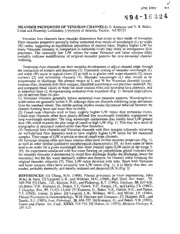
NASA Technical Reports Server (NTRS) 19940011851: Meander properties of Venusian channels PDF
Preview NASA Technical Reports Server (NTRS) 19940011851: Meander properties of Venusian channels
LPSC XXIV 815 / / N94-16 32.4 MEANDER PROPERTIES OF VENUSIAN CHANNELS; G. Komatsu and V. R. Baker, Lunar and Planetary Laboratory, University of Arizona, Tucson, AZ 85721 Venusian lava channels have meander dimensions that relate to their mode of formation. Their meander properties generally follow terrestrial river trends of wavelength (L) to width (W) ratios, suggesting an equilibrium adjustment of channel form. Slightly higher L/W for many Venusian channels in comparison to terrestrial rivers may relate to nonaqueous flow processes. The unusually low L/W values for some Venusian and lunar sinuous tilles probably indicate modification of original meander patterns by lava-erosional channel widening. Terrestrial fiver channels use their meander development to adjust channel slope through the interaction of erosion and deposition [1]. Consistent scaling of meander wavelength (L) and width (W) occur in typical rivers [2] as well as in glacier melt water channels [2], ocean currents [2] and submarine channels [3]. Meander wavelength (L) also trends to be proportional to discharge. We plotted ranges of L and W for Venusian channels (canali, sinuous rilles, channels with flow margins, classified according to our previous studies[4, 5]), and compared these values to those for lunar sinuous rilles and terrestrial lava channels, and to empirical lines [2, 6] representing terrestrial fiver meanders (Fig. 1). Several implications can be derived from the plot: (1) Venusian channels generally follow terrestrial river meander patterns. Wavelength-to- width ratios are generally within 5-30, although there are channels exhibiting large deviations from the standard values. The similar scaling implies similar dynamical behavior between the channel-forming lavas and water flow in rivers. (2) Canali-type channels tend to have slightly higher LAV ratios than terrestrial rivers. Canali-type channels often have poorly defined low wavelength meanders superposed on long wavelength meanders. The long wavelength components may locally have L/W greater than 100, which expands the plot range of canali to high L/W (Fig. 1). This may be a result of topographic or structural control rather than flow dynamics. (3) Terrestrial lava channels and Venusian channels with flow margins (channels occurring on well-defined flow deposits) tend to have slightly higher L/W ratios for the measured samples. Their range of L/W is similar to that of canali-type channels. (4) Venusian sinuous rilles and lunar sinuous tilles have similar meander properties (Fig. 1), as well as other similar qualitative morphological characteristics [4]. At least some of them tend to be wider for a given wavelength than other channel types (L/W ratios in the range 2- 10). An experiment conducted with hot water flowing on polyethylene glycol indicates that the meander sinuosity is determined by initial flow discharge (higher the discharge, lower the sinuosity), but the hot water thermally widens and deepens the channel while retaining the original meander sinuosity [7]. Thus, LAV ratios decrease with time. Since both Venusian and lunar sinuous rilles have unusually low L/W ratios (Fig. 1), it is likely that they are eroded, probably thermally, and thereby widened and deepened [8, 9] (Fig. 2) REFERENCES: [1] Chang, H.H. (1988), Fluvial processes in river engineering, John Wiley & Sons. [2] Leopold, L.B., and Wolman, M.G. (1960), Bull. Geol. Soc. Amer., 71, 769-794. [3] Clark, J.D., Kenyon, N.H., and Picketing, K.T. (1992), Geology, 20, 633-636. [4] Baker, V.R., Komatsu, G., Parker, T.J., Gulick, V.C., Kargel, J.S., and Lewis, J.S. (1992), J. Geophys. Res., 97, 13,421-13,444. [5] Komatsu, G., Baker, V.R., Gulick, V.C., and Parker, T.J. (1992), Icarus, in press. [6] Leopold, L.B., Wolman, M.G., and Millar, J.P. (1964), Fluvial Processes in Geomorphology, W.H. Freeman and Company. [7] Huppert, H.E., and Sparks, S.J. (1985), Jour. Petrology, 26, 694-725. [8] Komatsu, G., and Baker, V.R. (1992), Lunar and Planet. Sci. Conf., XXIII, 715-716. [9] Hulme, G. (1973), Modern Geology, 4, 107-117. 816 LPSC XXIV MEANDERS OF VENUSIAN CHANNEL: G. Komatsu and V.R. Baker 1000 100 Venusian Channels f-- _ lO with Flow Margins Hawaiian Lava Channels _"'Venusian and Lunar Sinuous Rilles 0.1 / L=I0.9WI.01 "_ L=6.6W0.99 0.01 0.001 0.01 0.1 1 10 100 Width (km) Fig. 1 Meander Wavelength (L)/Channel Width(W) plot of Venusian, lunar, terrestrial channels. Ranges of data points are shown. Fig. 2 Venusian sinuous rilles cutting through massifs in highland plains of Aphrodite Terra. These are examples of erosional processes involved in the channel formation.
